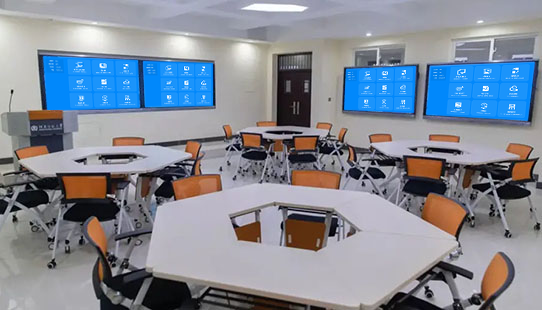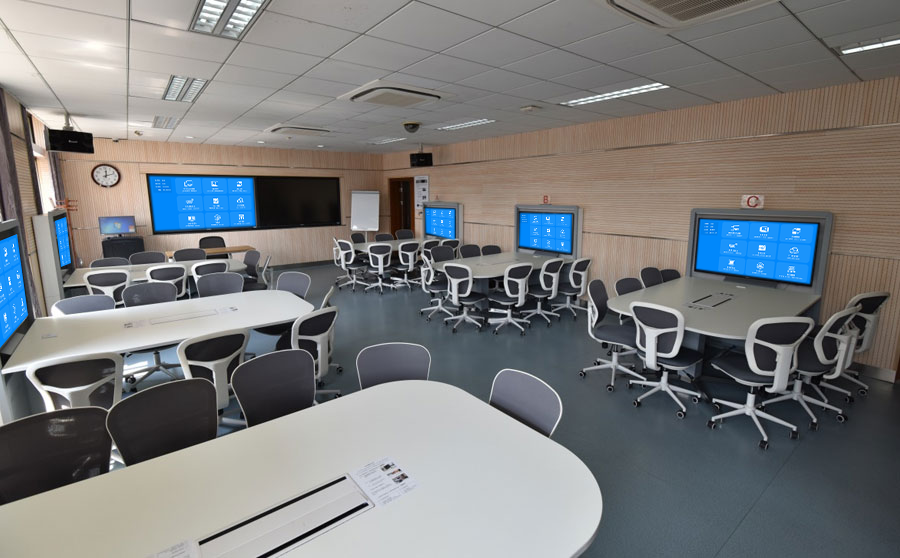Interactive Classroom: Making Teaching More Engaging
The interactive classroom solution integrates multi-device collaboration, diverse interactive features, and smart teaching functions. It breaks through the limitations of traditional classrooms and is suitable for primary and secondary school teaching, university courses, and vocational training. It creates an integrated “teach–learn–assess” environment that makes knowledge transfer more efficient and the classroom atmosphere more lively.
Universal Device Collaboration, Building an Interactive Foundation
This solution is compatible with teacher devices (computers, tablets, phones), student devices (tablets, clickers), and teaching terminals (smart boards, projectors, recording equipment), enabling a seamless, end-to-end connection:
- Instant Connection: A teacher’s device can connect to a large display in 2 seconds with wireless mirroring, and students can join the classroom system by scanning a code in 1 second, with no complex wiring or software installation required.
- Multi-Screen Sync: Lessons, annotations, and exercises are synchronized to student devices in real time and can be saved to their personal learning space with one click for easy review.
- Cross-Device Collaboration: A teacher can use a tablet to highlight key points or a phone to record a lab process. The content is instantly mirrored to the large display. Students can also go up to the board and use a stylus to write, making interaction as good as with a traditional blackboard.

Diverse Interactive Functions, Activating the Classroom
1. Precise Teaching Interaction
- Real-Time Quiz Feedback: It supports various question types, including multiple choice, true/false, subjective questions, and polls. After students answer, the large display automatically generates a data report (correctness rate and distribution of wrong answers). A teacher can then address weak points, moving beyond a “full-class lecture.”
- Group Discussion Collaboration: You can quickly divide students into study groups. Each group has its own shared whiteboard and file transfer space. The group’s work is displayed in a “split-screen view,” making inter-group peer review and teacher feedback more intuitive.
- Random Interaction: A teacher can initiate a “random roll call” or “raise your hand” question. Students can respond with their devices, and a points reward system encourages everyone to participate and reduces “silent zones” in the classroom.
2. Immersive Scene-Based Teaching
- Multimedia Integration: It supports synchronizing various materials like lessons, 3D models, VR virtual scenes, and lab animations. When explaining a biological cell, a teacher can rotate a 3D model 360 degrees. When explaining physics, a teacher can play a dynamic lab process, which makes abstract knowledge tangible.
- Live Object Magnification: A high-definition camera can be used to mirror books, lab equipment, and student homework to a large display, magnifying details so everyone can see them clearly. Paired with an “annotation and explanation” function, a teacher can highlight key points in real time.
- Smart Whiteboard Linkage: The large display has a built-in electronic whiteboard function. It supports handwriting, drawing, and handwriting recognition (auto-converting formulas and text). A teacher can directly annotate key points on the lesson, and the content is automatically synchronized to student devices, so no key information is missed.
3. Different Scenarios
- Basic Teaching: For primary and secondary school classrooms, it has built-in interactive modules for spelling, vocabulary memorization, and reading along with text. The system automatically grades it and generates a “mistake notebook,” which reduces the teacher’s workload.
- Vocational Training: In a vocational school’s lab, a teacher’s hands-on process is mirrored to a large display with a camera. Close-up details (like circuit welding) are clearly shown. Students can follow the steps and practice, while the teacher can remotely check their progress on a tablet and give guidance.
- Outdoor Studies: In an environment with no network, it supports a direct device connection for mirroring. A teacher can use a phone to take photos of real-life objects and mirror them to a mobile large display for a real-time explanation, which deeply links knowledge with the real world.
Smart Management and Data Analysis, Empowering Teaching
More Efficient Teaching Management
- Classroom Control: A teacher can remotely lock student devices (disabling irrelevant apps, pushing content) and use “tiered control” to push different learning tasks to different students, enabling personalized teaching.
- Efficient Resource Retrieval: It has a built-in school resource library that stores lessons and exercises categorized by subject, grade, and knowledge point. A teacher can quickly retrieve them and also upload their own resources and share them with the class.
- Integrated Attendance and Recording: When students scan a code to join the class, attendance is automatically recorded. The entire class is recorded, and it automatically synchronizes lessons, annotations, and interaction records. After class, a “class replay” is generated for students to review or for teachers to use for research.
Data to Improve Teaching
- Precise Learning Analytics: It automatically records students’ quiz correctness, class participation, and homework completion. It generates individual and class learning reports that pinpoint weak points, and a teacher can use this data to adjust their teaching focus.
- Objective Teaching Evaluation: It records a teacher’s class interaction frequency and resource usage, providing an objective basis for teaching evaluations. It also supports a “class evaluation mode,” so other teachers can use their devices to give feedback, and a class evaluation report is generated after class.
Simple Deployment and Low-Barrier Use
- Flexible Deployment: It can be used for building a new smart classroom from scratch or upgrading an existing traditional classroom, with no need for large-scale demolition.
- Simple Operation: The interface is designed to match teaching habits, with clear function sections. A teacher can get the hang of it after just 1-2 training sessions. Students don’t have to install any apps and can start using it by scanning a code, so there’s no learning curve.
- Remote Maintenance: An administrator can monitor the status of devices in each classroom in real time (online status, signal strength) and perform remote on/off and firmware upgrades, which reduces maintenance costs.
Whether for daily teaching, a public class, vocational training, or outdoor studies, this interactive classroom solution can help classrooms shift from “one-way teaching” to “two-way interaction,” boosting both teaching quality and learning outcomes.